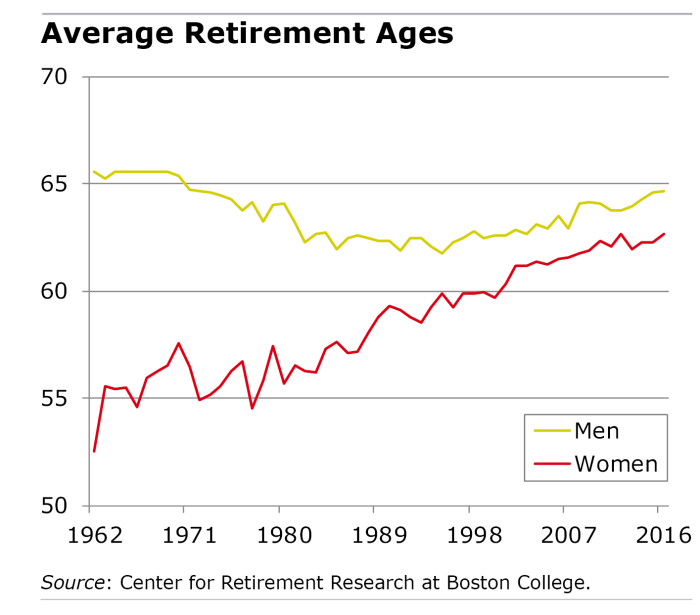Get ready to dive into the world of retirement age statistics, where numbers and trends paint a fascinating picture of societal norms and economic landscapes. Brace yourself for a journey filled with insights and surprises that will keep you hooked till the end.
Let’s explore the various facets of retirement age statistics and unravel the mysteries behind this crucial aspect of our society.
Overview of Retirement Age Statistics
When it comes to retirement age statistics, we are diving deep into the numbers that show at what age people are choosing to step back from the workforce and enjoy their golden years. These statistics are crucial for understanding the demographics of the workforce, planning for the future, and assessing the financial health of a country’s social security system.
Retirement age statistics vary greatly across different countries due to factors such as life expectancy, healthcare systems, and government policies. Some countries have a set retirement age mandated by law, while others allow individuals to retire whenever they choose, depending on their financial situation and personal preferences.
Variation in Retirement Age Across Countries
In the United States, the full retirement age for Social Security benefits is currently 66 or 67, depending on the year of birth. However, many Americans choose to retire earlier or later based on their financial readiness and health status. On the other hand, countries like France have a lower retirement age, with some professions allowing individuals to retire in their early 60s.
- In Japan, the retirement age is typically around 60 to 65, but the government is considering raising it due to the aging population and increasing life expectancy.
- In Germany, the retirement age is gradually increasing from 65 to 67 to address the challenges posed by an aging workforce and a shrinking labor pool.
- On the other hand, countries like Sweden have a flexible retirement age system, allowing individuals to choose when to retire between the ages of 61 and 67, with different benefits based on the chosen age.
Factors Influencing Retirement Age
The retirement age of individuals is influenced by a variety of factors that can impact when they decide to stop working and begin their retirement. These factors can range from personal preferences to broader economic conditions.
Economic Conditions
Economic conditions play a significant role in determining the retirement age of individuals. During times of economic prosperity, individuals may feel more financially secure and choose to retire earlier. On the other hand, during economic downturns or recessions, individuals may be forced to delay their retirement due to financial constraints. The stability of the job market, inflation rates, and the performance of retirement savings and investments can all impact the retirement age trends.
Life Expectancy Changes
Changes in life expectancy can also influence retirement age statistics. As life expectancy increases, individuals may choose to work longer in order to ensure they have enough savings to support themselves throughout their extended retirement years. Additionally, improvements in healthcare and overall quality of life can lead to individuals staying active in the workforce for a longer period of time.
Retirement Age Trends by Gender
In today’s society, retirement age trends vary between men and women due to a combination of factors such as societal norms, gender roles, and financial considerations. Let’s take a closer look at the differences in retirement age between genders.
Retirement Age Statistics for Men and Women
- On average, men tend to retire later than women, with statistics showing that the retirement age for men is around 65 years old, while for women it is around 63 years old.
- This difference can be attributed to various factors, including career opportunities, wage gaps, and caregiving responsibilities.
Societal Norms and Gender Roles
- Traditional gender roles often dictate that men are the primary breadwinners in a household, which may lead to longer working careers for men.
- Conversely, women are more likely to take on caregiving roles, which can impact their ability to work full-time and contribute to earlier retirement ages.
- Changing societal norms and the push for gender equality in the workforce are slowly shifting these trends, with more women choosing to work longer and delay retirement.
Retirement Age and Health

Health plays a significant role in determining when individuals choose to retire. Let’s dive into the relationship between retirement age and health status, and how health conditions can impact retirement decisions.
Impact of Health on Retirement Age
- Health conditions such as chronic illnesses or disabilities can prompt individuals to retire earlier than planned.
- Conversely, those who maintain good health may choose to work longer and delay retirement.
- Studies show that individuals with poor health are more likely to retire early, affecting retirement age trends.
Global Comparison of Retirement Age
When looking at retirement age across different countries, we can see a wide range of variations influenced by cultural, economic, and social factors.
Retirement Age Comparison Table
| Country | Normal Retirement Age |
|---|---|
| United States | 65-67 |
| France | 62 |
| Japan | 65 |
| Germany | 67 |
Cultural Influence on Retirement Age
Cultural norms and values play a significant role in determining the retirement age in different countries. For example, in some cultures, there is a strong emphasis on family and community support for older individuals, leading to later retirement ages. On the other hand, cultures that prioritize individualism and productivity may have earlier retirement ages.
Trends and Outliers
- Many European countries have lower retirement ages compared to countries in Asia or North America.
- Some outliers include countries like Sweden, where the retirement age is gradually increasing to 67, reflecting changing economic and demographic trends.
